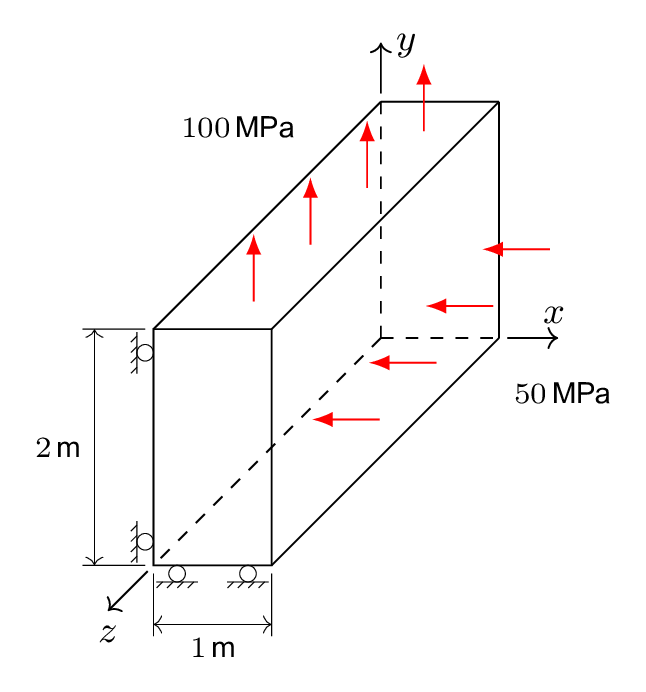Tutorial: longWall
Prepared by Iago Lessa de Oliveira
Tutorial Aims
- Demonstrate how to perform a solid-only analysis in solids4foam;
- Exemplify the use of a hyperelastic mechanical law with large deformations.
Case Overview

Figure 1: Deformation of a long wall under two forces
This benchmark consists of a wall with 1 m x 2 m (width x height) and assumed infinitely long in length, i.e. along the z-axis (see Figure 1). Due to symmetry, it can be assumed to be in a biaxial deformation state. A compressing load of 50 MPa is applied on the right surface, and a traction of 100 MPa on the upper surface. The left and bottom surfaces are free to slide along its tangential but constrained to move along their normal. The material was assumed isotropic and incompressible and characterised by the Mooney-Rivlin hyperelastic law, with material parameters c10 = 80 MPa, c01 = 20 MPa, and c11 = 0.0 MPa, under plane-strain conditions (see the file constant/mechanicalProperties to change these values).
The default mesh in the tutorial had 20 x 20 volumes. You can use both total and updated Lagrangian approaches in this tutorial because both yielded the same results in terms of accuracy and convergence speed. For the results presented here, we employed the nonLinearGeometryTotalLagrangian model, one of the total Lagrangian approaches available that solves for the increment of the displacement, which is why you have to use the DD file in the directory 0/.
The boundary conditions were applied in 100 equal incremental steps and note the use of the fixedDisplacementZeroShear boundary condition applied to the bottom and left surfaces of the wall that must be allowed to slip freely but constrained in their normal direction. A normalised residual tolerance for the momentum equation of 10-8 was used.
Expected Results
The results are compared in Table 1 against two references: one numerical and another analytical provided by I. Bijelonja, I. Demirdžić, and S. Muzaferija, "A finite volume method for large strain analysis of incompressible hyperelastic materials," International Journal for Numerical Methods in Engineering, vol. 64, pp. 1594–1609, Nov. 2005, doi: 10.1002/nme.1413. . The σxx and σyy are the Cauchy stress components along the x and y directions, respectively, while ux and uy are the total displacements along the x and y directions.
Table 1: Comparison of Cauchy stress and the wall displacement in the x and y directions.
| Source | σxx (MPa) | σyy (MPa) | ux (m) | uy (m) |
|---|---|---|---|---|
| solids4foam | -49.99 | 100.0 | -0.1636 | 0.4010 |
| Reference | -49.00 | 100.0 | -0.1676 | 0.4022 |
| Analytical | -50.00 | 100.0 | -0.1675 | 0.4025 |